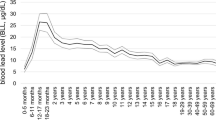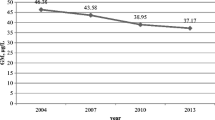Abstract
Environmental lead contamination in Uruguay became a matter of public concern in 2001, when cases of children with blood lead levels (BLL) higher than 20 μg/dl appeared in some low-income neighborhoods of Montevideo, being 10 μg/dl the intervention reference BLL. The aim of this paper is to show the results of multidisciplinary actions taken by decisions makers in social, environmental and healthcare aspects, to minimize lead exposure risks. We evaluated changes in blood lead levels of different children and non-exposed adult populations before and after the actions were taken, from 2001 on. For children populations and non-exposed adults, we found a significant decrease of almost 50% in BLL compared with studies done before the actions were taken. The main action to consider was the phasing out process of leaded gasoline in our country among other. We conclude that the integration of inter and multidisciplinary actions promoted was of high impact on the population, bringing about a public sensitization and growing awareness of the lead environmental risks.
Similar content being viewed by others
References
ACGIH. (2009). TLVs and BEIs. Based on the documentations for threshold limit values for chemical substances and physical agents. Biological exposure indices. American Conference of Governmental Industrial Hygienists.
Barañano, R., Mañay, N., Pereira, L., Cousillas, A., Moratorio, G., & Dibarboure, H. (2004). Estudio Observacional: Niveles de plumbemia en población en edad laboral activa en una ciudad rioplatense. Proceedings VII Congreso Iberoamericano de Medicina del Trabajo 2005.
Bellinger, D. (1994). Lead. Pediatrics, 113(4), 1016–1022.
Cousillas, A., Mañay, N., Pereira, L., Alvarez, C., & Coppes, Z. (2005). Evaluation of lead exposure in Uruguayan children. Bulletin of Environmental Contamination and Toxicology, 75(4), 629–636.
Cousillas, A., Mañay, N., Pereira, L., & Rampoldi, O. (1998). Relevamiento de plumbemias en un complejo habitacional de Montevideo (Uruguay). Acta Farmaceutica Bonaerense, 17(4), 291–296.
Cousillas, A., Pereira, L., Alvarez, C., Heller, T., de Mattos, B., Piastra, C., et al. (2008). Comparative study of blood lead levels in Uruguayan children (1994–2004). Biological Trace Element Research, 122, 19–25.
Hessel, D. W. (1968). A simple and rapid quantitative determination of lead in blood. Atomic Absorpt Newsletter, 7, 55–57.
IMM. (2003). Contaminación por Metales en suelo. In Informe Ambiental de Montevideo. Intendencia Municipal de Montevideo. Documento de desarrollo Ambiental. http://www.montevideo.gub.uy/ambiente/documentos/infoamb03c.pdf.
IPCS (International Programme on Chemical Safety). (1995). Environmental health criteria no 165: Inorganic lead. Geneva, Switzerland: World Health Organization.
Lauwerys, R. (1994). Toxicología industrial e intoxicaciones profesionales. Masson, SA.
Mañay, N., Alonzo, C., & Dol, I. (2003). Contaminación por plomo en el barrio La Teja; Montevideo Uruguay. Salud Publica de Mexico, 45(2), 268–275.
Mañay, N., Cousillas, A., Alvarez, C., & Heller, T. (2008). Lead contamination in Uruguay: The “La Teja” neighborhood case. Reviews of Environmental Contamination and Toxicology, 195, 93–115.
Mañay, N., Cousillas, A., Pereira, L., & Alvarez, C. (2005). Lead biomonitoring on dogs as sentinels for risk environment assessment. In XIII international conference on heavy metals in the environment proceedings (pp. 221–224).
Mañay, N., Pereira, L., & Cousillas, A. (1999). Lead contamination in Uruguay. Reviews of Environmental Contamination and Toxicology, 159, 25–39.
NIOSH. (1984). National institute of occupational and safety health. In Manual of analytical methods. Cincinnati.
Pereira, L., Mañay, N., Cousillas, A., Barregard, L., Schutz, A., & Sällsten, G. (1996). Occupational lead exposure in Montevideo. Uruguay. International Journal of Occupation and Environmental Health, 2(4), 328–330.
Schutz, A., Barregard, L., Sallsten, G., Wilske, J., Mañay, N., Pereira, L., et al. (1997). Blood lead in Uruguayan children and possible sources of exposure. Environmental Research, 74, 17.
Singerman, A. (1984). Exposure to toxic metals: Biological effects and their monitoring. In A. Vercruysse (Ed.), Hazardous metals in human toxicology (p. 17). Elsevier, London.
Taylor, D. G. (1975). Lead in blood and urine. Physical and chemical analysis branch. Analysis Method P, CAM 208 NIOSH.
United States Center of Disease Control (US CDC). (1991). Preventing lead poisoning in young children. A statement by the center of disease control US. Department of Health and Human Services, Atlanta, Georgia. http://wonder.cdc.gov/wonder/prevguid/p0000029/p0000029.asp.
Uruguayan Legislative Power 2004a Law 17.775. (2003a). After December 31, gasoline with more than 13 mg/L lead is banned.
Uruguayan Legislative Power 2004b, Law No 17.774 (2003b). Lead in blood analysis in exposed workers.
US CDC. (2002). Centers for disease control and prevention. Managing elevated blood lead levels among young children: Recommendations from the advisory committee on childhood lead poisoning prevention. US. Department of Health and Human Services Atlanta. http://www.cdc.gov/nceh/lead/CaseManagement/caseManage_main.htm.
Author information
Authors and Affiliations
Corresponding author
Rights and permissions
About this article
Cite this article
Cousillas, A., Pereira, L., Heller, T. et al. Impacts of multidisciplinary actions on environmental lead exposure in Uruguay. Environ Geochem Health 34, 207–211 (2012). https://doi.org/10.1007/s10653-011-9426-y
Received:
Accepted:
Published:
Issue Date:
DOI: https://doi.org/10.1007/s10653-011-9426-y




